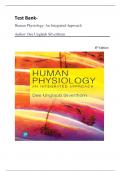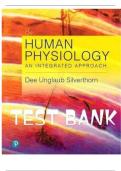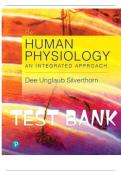Test Bank-
Human Physiology: An Integrated Approach
Author: Dee Unglaub Silverthorn
8th Edition
,Table Of Contents
Chapter 1 Introduction To Physiology
Chapter 2 Molecular Interactions
Chapter 3 Compartmentation: Cells And Tissues
Chapter 4 Energy And Cellular Metabolism
Chapter 5 Membrane Dynamics
Chapter 6 Communication, Integration, And Homeostasis
Chapter 7 Introduction To The Endocrine System
Chapter 8 Neurons: Cellular And Network Properties
Chapter 9 The Central Nervous System
Chapter 10 Sensory Physiology
Chapter 11 Efferent Division: Autonomic And Somatic Motor Control
Chapter 12 Muscles
Chapter 13 Integrative Physiology I: Control Of Body Movement
Chapter 14 Cardiovascular Physiology
Chapter 15 Blood Flow And The Control Of Blood Pressure
Chapter 16 Blood
Chapter 17 Mechanics Of Breathing
Chapter 18 Gas Exchange And Transport
Chapter 19 The Kidneys
Chapter 20 Integrative Physiology Ii: Fluid And Electrolyte Balance
Chapter 21 The Digestive System
Chapter 22 Metabolism And Energy Balance
Chapter 23 Endocrine Control Of Growth And Metabolism
Chapter 24 The Immune System
Chapter 25 Integrative Physiology Iii: Exercise
Chapter 26 Reproduction And Development
,Chapter 1 Introduction To Physiology
1) Physiology Is The Study Of
A) The Structure Of The Body.
B) The Tissues And Organs Of The Body At The Microscopic Level.
C) Growth And Reproduction.
D) The Normal Functions Of The Organ Systems.
E) The Facial Features As An Indication Of Personality.
:D
Section Title: The Science Of Physiology Learning Outcome: 1.5
: Level I: Reviewing Facts And Terms (Bloom's Taxonomy: Knowledge)
2) The Literal Meaning Of The Term Physiology Is Knowledge Of
A) Organs.
B) Nature.
C) Science.
D) Chemistry.
E) Math.
:B
Section Title: The Science Of Physiology Learning Outcome: 1.5
: Level I: Reviewing Facts And Terms (Bloom's Taxonomy: Knowledge)
3) Because Anatomy And Physiology Have Different Definitions, They Are Usually Considered
Separately In Studies Of The Body.
A) True
B) False
:B
Section Title: The Science Of Physiology Learning Outcome: 1.5
, : Level I: Reviewing Facts And Terms (Bloom's Taxonomy: Knowledge)
4) The Following Is A List Of Several Levels Of Organization That Make Up The Human Body.
1. Tissue
2. Cell
3. Organ
4. Molecule
5. Organism
6. Organ System
The Correct Order From The Smallest To The Largest Is
A) 2, 4, 1, 3, 6, 5.
B) 4, 2, 1, 6, 3, 5.
C) 4, 2, 1, 3, 6, 5.
D) 4, 2, 3, 1, 6, 5.
E) 6, 4, 5, 2, 3, 1.
:C
Section Title: The Science Of Physiology Learning Outcome: 1.1
: Level I: Reviewing Facts And Terms (Bloom's Taxonomy: Knowledge)
5) "Glucose Is Transported From Blood Into Cells Because Cells Require Glucose To Meet Their
Energy Needs." This Type Of Explanation Is
A) Mechanistic.
B) Theological.
C) Teleological.
D) Metalogical.






